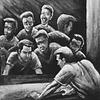Take a photo of a barcode or cover
Amazingly clear introduction to science and how it helps discover the magic in nature. Perhaps it has been written for young readers and/or for people with little science background.
I loved it "although" I am 53 and I got a degree in physics. ;-)
I loved it "although" I am 53 and I got a degree in physics. ;-)
informative
inspiring
medium-paced
informative
slow-paced
At first I thought I wouldn't learn anything fascinating from the topics chosen by the author, but it turns out I found myself thinking about these facts randomly during the day. This book is an easy read, and I finally understand rainbows! To conclude with a passage from the book: "Science has its own magic: the magic of reality".
challenging
informative
Dawkins at his grandfatherliest. This book is aimed towards a roughly pre-teen audience and I enjoyed his ways of simple explanation while keeping the fundamentals intact. Each chapter asks a basic question, and the first chunk of each chapter tells some of the myths people have created to answer them, followed by the actual answers as discovered by science. Among other things, I learned about spectroscopes (telescopes that detect rainbows) and Dawkins's dislike of any Pink Panther films after the first one.
emotional
informative
inspiring
reflective
medium-paced
This book is in general good and informative, but it occasionally has a slightly condescending tone towards people skeptical towards science, which in my eyes, hurts the general idea of the book (telling all people how great the world and science exploring it is). If that weren't the case, I might rate it one star higher. In it's current form, I can only recommend it to people who are into science already - but these probably will not be able learn too much new from it...
As usual, Richard Dawkins enlightens his readers on complex subjects written in a clear and logical narrative. Always a pleasure to read.
Reality is having a pretty hard time these days, with violent religious fanatics more active in the world than they've been for centuries, and with media companies and lobby firms actively campaigning against science in the service of world-damaging enterprises. It could use some champions.
The Magic of Reality: How We Know What's Really True is a persuasive text, aimed primarily at younger readers who don't know much about science. The target audience isn't science geeks, who'll be reading adult popular science books, but their non-geek contemporaries, the kids who might be vulnerable to the forces of irreality. That is to say, to religion. Although the target audience is curious children, I'm sure most adult readers would also learn some new and interesting things from it.
The book's core message is that science is not just another belief system, but is the only reality-based belief system, one based ultimately on what we perceive with our senses. It's the only belief system that can stand up to intelligent scrutiny, that can make useful predictions, that makes claims that can be proved or disproved, that can grow and change to accommodate new discoveries and observations. It's the only belief system that can provide non-silly answers to the questions about the world that occur to thoughtful people.
The book provides clear, concise answers to some of those questions. Most of the questions are scientific, such as 'Why do earthquakes happen?' and 'Why are there so many different kinds of animals?' Some belong more to the metaphysical domain in which religions might try to claim authority, such as 'Why do bad things happen?' I was initially sceptical about whether that latter chapter belonged, but it delved into some interesting and worthwhile aspects of probability that justified its presence.
Richard Dawkins's antipathy to religion is well-known, and in this reader he is preaching to the choir. I suspect he mainly preaches to the choir, because religious believers won't read books with titles like The God Delusion. He reins in his atheistic fervour in this book, though it still emerges, to the book's detriment. Most chapters are prefaced with mythological stories that provide unscientific answers to scientific questions. Dawkins is seldom content to merely tell the myth: he has to take the piss. I felt some of the myths were never intended to be the literal truth by the people who told them, but were playful expressions of the arbitrariness of the way things are. But because many of these stories are essentially comical it's easy to make them and the people who supposedly believed them seem foolish.
Kids aren't stupid, and I think they are as likely as I to detect the 'propaganda' aspect of the book, and to be put off by it. That would be a shame. My ideal version of the book, as an effective weapon in the fight against irreality, would consist of Dawkins's well-written, clear answers, without the myths. The plain truth, written well in language the reader can understand, is persuasive enough.
PS: I read a paperback edition which has illustrations only on the chapter heads, depicting scenes from myth. I felt that some of the scientific explanations would benefit from diagrams, and I believe the hardback version of the book includes them. I'd recommend reading the fully illustrated version if you can.
The Magic of Reality: How We Know What's Really True is a persuasive text, aimed primarily at younger readers who don't know much about science. The target audience isn't science geeks, who'll be reading adult popular science books, but their non-geek contemporaries, the kids who might be vulnerable to the forces of irreality. That is to say, to religion. Although the target audience is curious children, I'm sure most adult readers would also learn some new and interesting things from it.
The book's core message is that science is not just another belief system, but is the only reality-based belief system, one based ultimately on what we perceive with our senses. It's the only belief system that can stand up to intelligent scrutiny, that can make useful predictions, that makes claims that can be proved or disproved, that can grow and change to accommodate new discoveries and observations. It's the only belief system that can provide non-silly answers to the questions about the world that occur to thoughtful people.
The book provides clear, concise answers to some of those questions. Most of the questions are scientific, such as 'Why do earthquakes happen?' and 'Why are there so many different kinds of animals?' Some belong more to the metaphysical domain in which religions might try to claim authority, such as 'Why do bad things happen?' I was initially sceptical about whether that latter chapter belonged, but it delved into some interesting and worthwhile aspects of probability that justified its presence.
Richard Dawkins's antipathy to religion is well-known, and in this reader he is preaching to the choir. I suspect he mainly preaches to the choir, because religious believers won't read books with titles like The God Delusion. He reins in his atheistic fervour in this book, though it still emerges, to the book's detriment. Most chapters are prefaced with mythological stories that provide unscientific answers to scientific questions. Dawkins is seldom content to merely tell the myth: he has to take the piss. I felt some of the myths were never intended to be the literal truth by the people who told them, but were playful expressions of the arbitrariness of the way things are. But because many of these stories are essentially comical it's easy to make them and the people who supposedly believed them seem foolish.
Kids aren't stupid, and I think they are as likely as I to detect the 'propaganda' aspect of the book, and to be put off by it. That would be a shame. My ideal version of the book, as an effective weapon in the fight against irreality, would consist of Dawkins's well-written, clear answers, without the myths. The plain truth, written well in language the reader can understand, is persuasive enough.
PS: I read a paperback edition which has illustrations only on the chapter heads, depicting scenes from myth. I felt that some of the scientific explanations would benefit from diagrams, and I believe the hardback version of the book includes them. I'd recommend reading the fully illustrated version if you can.
If I had to recommend one popular science book for children/teens to study in schools here, it would be this. It's absolutely amazing and mind-blowing how seemingly complex matters can be made to be understood so easily, by everyone.
Now, you might think that this book is for children/young adults only. Wrong. I knew almost everything mentioned in this book but I don't think I ever really truly understood it that simply before. It will clarify what you already knew and make it easier for you to explain it to others. Either way, it's a fun read and it is aesthetically pleasing. I think I'll purchase the hardcover version of this book (the one I have is from iBooks), and keep it in my shelf for future reference - or whenever I need to explain something to someone. I will also try to get my nieces/nephews to read it once they are old enough to understand.
The chapters include:
1- What is reality? What is magic?
2- Who was the first person?
3- Why are there so many different kinds of animals?
4- What are things made of?
5- Why do we have night and day, winter and summer?
6- What is the sun?
7- What is a rainbow?
8- When and how did everything begin?
9- Are we alone?
10- What is an earthquake?
11- Why do bad things happen?
12- What is a miracle?
The God Delusion might have been a disappointment, but this book made Richard Dawkins awesome again. I am truly impressed.
This book isn't written for me. I'd guess that this book is written for the late elementary school/middle school set. It's filled with facts and stories and while it doesn't talk down to you, it's definitely written in a more simple language and repeats quite often to drive home a point. I'd feel pretty confident giving this to my 2nd grader (who reads way above her grade level) to start some discussions. There are things in here that she wouldn't quite get, but that's where the discussion comes in. This is one I'll definitely buy for this purpose. However, keeping in mind that I'm the one who read this one, this only gets a B- from me.



